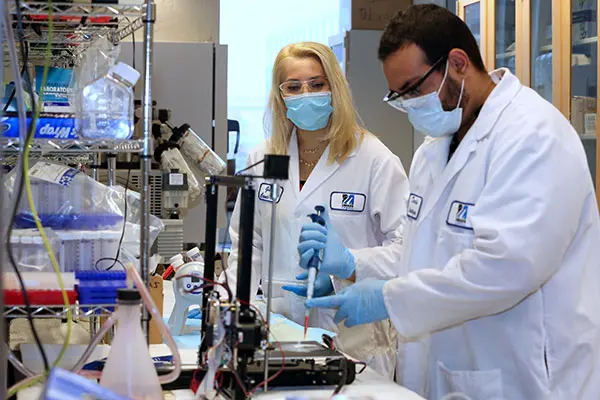Diagnostic Tool Could be Used at Home or in Health Care Setting

Asst. Prof. Gulden Camci-Unal and Ph.D. student Darlin Lantigua prepare reagents for their COVID-19diagnostic test at the Saab ETIC lab on North Campus.
10/21/2020
By Edwin L. Aguirre
A team of UMass Lowell researchers has invented a low-cost, portable and easy-to-use coronavirus diagnostic test that could deliver results in as little as five minutes.
“Many current coronavirus tests could take hours or days to return results,” says Chemical Engineering Asst. Prof. Gulden Camci-Unal, who has been leading the research since spring along with graduate student Darlin Lantigua. “Our new, single-use test, which uses a biosensor, would perform like a home pregnancy test.”
The test works with a wide range of body fluids, including blood, urine, saliva and nasal fluids.
“You place a sample on the device, and it would quickly detect the presence of SARS-CoV-2, the virus that causes COVID-19, even in very low concentrations,” she says.
The test is designed to be used by health care workers and first responders, but due to its simplicity, even untrained individuals would be able to use it and read the results at home, the researchers say.
“It could be used by ordinary people who have no medical training,” says Lantigua. “This eliminates the need for them to go outside to get tested and reduces the risk of further spreading the coronavirus.”
According to Camci-Unal, the primary methods used to detect the highly contagious pathogen include nucleic acid detection, real-time quantitative polymerase chain reaction and high-throughput genetic sequencing of nasal swabs or blood samples.
“However, these techniques are time-consuming, typically expensive and require highly trained personnel and sophisticated instrumentation to perform the test and interpret the results,” she notes. “Patients will greatly benefit from our diagnostic test since doctors can quickly isolate them and start treatment right away.”
From the Lab to the Market
“The biosensor is working very well in the laboratory, and we applied for a provisional patent for our invention this past summer,” Camci-Unal says.

An example of the team’s biosensor.
“We are confident that if we get a chance to test our biosensor with patient samples, we would obtain successful and reliable results,” Camci-Unal says.
The test’s release date would depend on how quickly they can obtain emergency use authorization from the U.S. Food and Drug Administration and mass-produce the optimized devices, she says.
“We need an industry partner to help us move our invention from the lab to the market,” explains Camci-Unal. “With the right partner and funding, the test could be ready for use within months at medical facilities. It takes a bit longer for the test to become available to the general public due to the FDA’s regulations.”
Biosensors are already an area of expertise for Camci-Unal, whose research at UMass Lowell includes work using such sensors for detecting diseases and other medical conditions as well as forensic reagents and toxic substances like heavy metals.
“We have a lot of experience in detecting viral and bacterial diseases,” Camci-Unal says of the team in her lab, which includes students like Lantigua.
Lantigua, who is pursuing a Ph.D. in biomedical engineering and biotechnology, already has master’s and bachelor’s degrees from UMass Lowell and is also part of the research team working with Camci-Unal on efforts to use pulverized eggshells to grow osteoblast cells for repairing bones.
